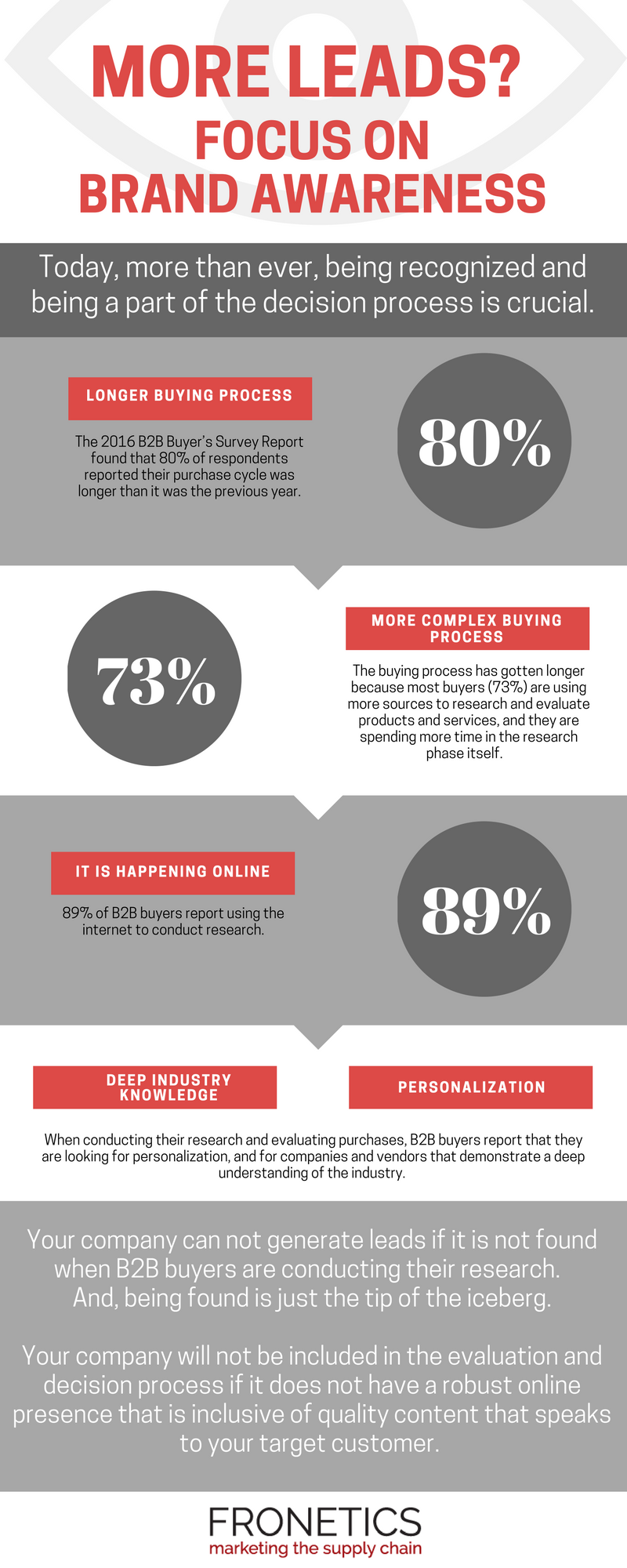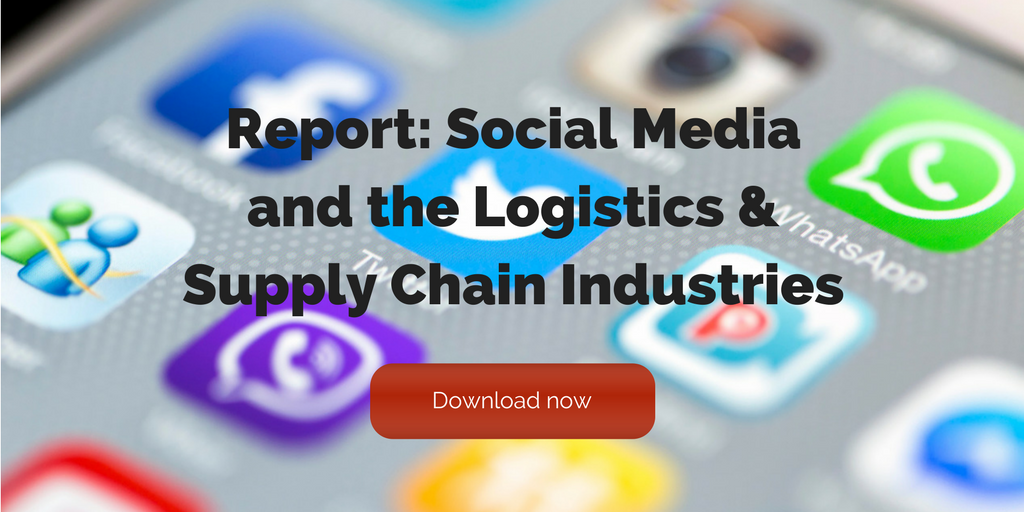
by Fronetics | Jan 9, 2017 | Blog, Content Marketing, Marketing, Social Media, Strategy, Supply Chain
Why brand awareness is important to growing your business
The singular goal of most companies that contact Fronetics is to generate more leads — today. This is not surprising in that leads are necessary to generate sales, and sales are necessary to revenue generation and to growth. What is surprising is the number of companies who do not recognize the critical role brand awareness plays in lead generation.
Brand awareness is the likelihood that your company’s brand, products, and services are recognized by consumers. Simply put, if consumers don’t know your company exists and/or don’t know what your company does or what your company offers, your company won’t be a part of their decision process.
Today, more than ever, being recognized and being a part of the decision process is crucial.
The new B2B buying process
The buying process for B2B buyers has become more complex and longer. The 2016 B2B Buyer’s Survey Report found that 80% of respondents reported their purchase cycle was longer than it was the previous year. The buying process has gotten longer because most buyers (73%) are using more sources to research and evaluate products and services, and they are spending more time in the research phase itself.
When conducting their research and evaluating purchases, B2B buyers report that they are looking for personalization, and for companies and vendors that demonstrate a deep understanding of the industry.
The place they are turning to conduct their research, and to evaluate purchases, is online: 89% of B2B buyers report using the internet to conduct research. Specifically, they are going online to: conduct web searches, look at vendor websites, read reviews, use social media, and participate in online forums.
The importance of investing in brand awareness
Your company can not generate leads if your company is not found when B2B buyers are conducting their research. And, being found is just the tip of the iceberg. Your company will not be included in the evaluation and decision process if it does not have a robust online presence that is inclusive of quality content that speaks to your target customer — that is, content that educates, informs, and identifies how your company can meet the needs of your target customers. It is about positioning your company as a knowledge leader, building trust, and establishing relationships. It is about brand awareness.
Building brand awareness takes time and dedication. Companies that are willing to invest their time and resources to brand awareness are rewarded – not just with leads, but with quality leads.
Too often, I see companies who are unwilling to invest either the time or money in brand awareness. One of the most frustrating things to see is a company that gives up too soon. These are companies who have realized significant gains — they have, for example, increased traffic to the website through organic, referral, direct, and social sources; decreased bounce rates; increased social reach; and increased social engagement. But, because their lead generation has not immediately sky rocketed, they decide to either reduce or eliminate their digital and content marketing activities. It is frustrating because these companies have built a strong foundation, and they are on the tipping point of success.
With the B2B buying process taking longer than ever, with buyers spending more time researching and evaluating their decisions, and with B2B buyers turning to the internet and critically evaluating companies on how they present themselves, investing the time and resources to brand awareness is critical.
As Geoffrey Chaucer said, “Patience is a conquering virtue.”

You may also like:

by Fronetics | Jan 5, 2017 | Blog, Content Marketing, Logistics, Marketing, Social Media, Supply Chain
Turn to these 7 Twitter accounts for news, insights, and thought leadership in the supply chain space.
Twitter is a platform for socializing, entertainment, breaking news, lead prospecting, and much more. But Twitter is only as useful as the people you follow. So how do you choose between the 317 million monthly active users?
We compiled our list of the must-follow Twitter accounts for the supply chain professional in 2017. These users and companies have a lot to offer in terms of news, insights, and thought leadership. They also are active posters, meaning you’ll see frequent content from them, and are listed in no particular order.
Are you following these 7 Twitter accounts for supply chain thought leadership?
Tania Seary was recently named “Influencer of the Year” by Supply Chain Dive and is an active poster on all things relating to supply chain logistics, with a particular commitment to procurement development. Based in London, Seary is the founder of Procurious, The Faculty, and The Source Australia.
Lora Cecere is the founder of Supply Chain Insights, an industry research group. A prolific writer, Cecere focuses on the changing face of enterprise technologies. Her current research interests include the digital consumer, supply chain sensing, demand shaping and revenue management, market-driven value networks, accelerating innovation through open design networks, the evolution of predictive analytics, emerging business intelligence solutions, and technologies to improve safe and secure product delivery.
Steve Banker is a veteran supply chain analyst who writes for Logistics Viewpoint and Forbes. Based outside of Boston, Banker heads up the Supply Chain & Logistics consulting team at ARC Advisory Firm. His technology focus areas include transportation management, managed transportation services, warehouse management, and supply chain planning.
Procurious is a business network and resource for progressive procurement professionals founded by Tania Seary. Content ranges from networking and career advice to thought leadership pieces and industry news.
Logistics Management offers editorial content aimed at executives, managers, and other professionals in the logistics and supply chain industries. It recently hosted virtual conference on streamlining logistics and supply chain operations.
Supply Chain Dive is a DC-based news aggregate that offers daily coverage of shipping / logistics / tracking, inventory management, storage / warehousing, freight & fulfillment.
Logistics News is an independent, global source for news related to transport, shipping, trucking, or logistics.
Are you following us? @fronetics distributes original content and curates interesting, informative, and relevant content from other supply chain publishers across the Twittersphere and beyond.
Who are your must-follow Twitter accounts?
Related posts:


by Fronetics | Jan 4, 2017 | Blog, Content Marketing, Logistics, Marketing, Supply Chain
Supply chain professionals should be following these eight blogs to keep up with the latest industry news and happenings in the coming year.
Fronetics is currently conducting a survey to determine which supply chain blogs you think are the best of 2017. (You can vote for that here.) But we also wanted to weigh in with some of the blogs we’re following.
These eight supply chain blogs are great resources for industry news and trends. They cover a range of topics, from technology to strategy, and feature thought leadership by some of the brightest minds in the field.
8 must-follow supply chain blogs
Here is our selection of blogs with timely content that supply chain executives need to read, in no particular order:
1) Supply Chain Management Review
This vast website includes trending articles on supply chain and logistics strategies developments, many written by university-level professors. Read this blog.
2) Logistics Viewpoints
This blog features think pieces from three leading supply chain and logistics analysts with the mission to provide clear and concise analyses of logistics trends, technologies and services. Read this blog.
3) Supply Chain Nation Blog
Interesting news bits from “around the supply chain horn,” this is JDA Software’s blog, a powerhouse in supply chain solutions. Read this blog.
4) Supply Chain Matters
The blog of Bob Ferrari offers his expertise on all aspects of supply chain business processes and supporting information technology. Read this blog.
5) Supply Chain Brain
A portal aimed at supply chain executives featuring original and aggregated content touching on multiple industries. Read this blog.
6) Supply Chain Shaman
Lora Cecere’s blog focuses on “the use of enterprise applications to drive supply chain excellence.” Read this blog.
7) Argentus Blog
Argentus is a boutique recruitment firm specializing in supply chain management and procurement. The blog offers insight into pressing issues in supply chain talent acquisition, career management, and more. Read this blog.
8) Cerasis Blog
The Cerasis blog covers industry trends, educates, explains rules and regulations, busts myths, and has awesome infographics. Read this blog.
Bonus/shameless plug: Fronetics Blog
Our blog covers topics of interest to the supply chain industry from marketing and social media to lead generation and strategy. Read our blog.
Related posts:


by Fronetics | Dec 13, 2016 | Blog, Content Marketing, Logistics, Marketing, Social Media, Supply Chain
Get the tools you need to create and implement a content marketing strategy that drives profitable customer action for your business.
Content marketing can be an incredibly effective tool for attracting customers and growing a business. But it ain’t easy. In fact, logistics and supply chain companies report creating and executing an effective content marketing strategy as one of their top challenges.
That’s why Fronetics created its Guide to Content Marketing for the Logistics & Supply Chain Industries. Newly updated to include even more helpful tips, tricks, and ideas, the guide offers step-by-step instructions for getting an effective content marketing program up and running.
If you are a DIY kind of person or are just looking to learn more about how to develop a modern-day marketing strategy for your business, this guide is a good place to start. Templates, lists, calendars, and more will walk you through the process of developing a strategy that aligns with your business goals.
Included in this guide is information regarding:
- Buyer personas
- Keyword development
- Content creation and distribution
- Social media participation
- Lead-nurturing workflows
- And more
Click the button below to download the new and improved guide and to get started creating a content marketing strategy that works for your business.

Related posts:

by Jennifer Hart Yim | Dec 12, 2016 | Blog, Strategy, Talent
Posting open positions to job boards don’t work for job seekers, and they create more busy work for employers. So why do companies still use them?
This guest post comes to us from Argentus Supply Chain Recruiting, a boutique recruitment firm specializing in Supply Chain Management and Procurement.
Every year, recruitment technology evolves. Skype comes along and offers an approximation of in-depth, in-person job interviews. New Applicant Tracking systems make the job application process more humane or, depending on your luck, more arduous, albeit efficient for hiring managers. New social media sourcing techniques allow recruiters to tap into networks of people they couldn’t find before. New websites and hiring tools emerge, claiming to be “talent networks” and insisting — when advertising themselves to recruiters — that they “aren’t job boards.”
For good reason. Whether you’re a recruiter, or a candidate looking for your next opportunity, or a company looking to hire, job boards don’t get you the best results.
In our opinion, it’s time to ditch them once and for all.
Job boards don’t work for job seekers
If you speak with a frustrated job seeker, you’ll inevitably hear that they’ve applied to dozens of jobs and never heard anything back. This is a symptom of the culture of job boards more than hiring managers’ indifference to any single applicant. The fact is, if you apply using a job board, your resume is going into a black hole among hundreds of other resumes. If anyone reads your resume at all, it’s likely a junior HR person doing the initial culling who doesn’t necessarily understand the nature of the job. A junior HR person who has 400 other resumes to review. A junior HR person who might get distracted by a phone notification, or a daydream, or a co-worker telling them there are cookies in the break room, and not even pay attention to your carefully crafted resume because there are just so many more to get through. Tons of jobs end up on job boards because the company wants to show that they’re reviewing outside applicants, even if they know they’re hiring internally. Beyond that, tons of jobs never even make it to job boards in the first place.
It’s easy to criticize job boards for being an impersonal way to assess hires. The thing is, that would be okay if job boards worked. But for most job seekers, they don’t.
So why do companies use them?
Don’t be part of the problem
A big part of it is the convenience: Job boards let companies adopt a “set it and forget it” mentality. It lets them post a job description, sit back and wait for the candidates to roll in. Easier than sourcing candidates, looking for referrals, working with external partners, right? Except that you’ve created a a ton of busywork for your team, and now they have to scan through tons of irrelevant resumes. You have to respond to those applications (and let’s be honest, many companies don’t) or risk taking a hit to your company’s reputation. You can ignore the irrelevant applications and contribute to the black hole mentality, making finding a job seem even less personable than it already is. Then you’re part of the problem, and what HR department wants to be part of the problem?
No one does. The paradox is that the easier job boards become to use, the less relevant the applications become. Once you can apply for a job with a single click (like on LinkedIn’s job postings), you can easily apply to hundreds of jobs that you have no business applying for. The mismatched resumes proliferate, and so does the busywork.
Thinking of hiring in terms of opportunity cost
One of the most difficult things to assess in business is the opportunity cost of decisions. Perhaps the biggest opportunity cost of using job boards is that you completely ignore the passive candidate market — people who aren’t looking for jobs, but would be open to a move. Any HR department or hiring manager worth their salt will source passive candidates in addition to using job boards. But if you rely on job boards entirely, you’re passing up what are the best candidates around.
For these and other reasons, we decided to stop using job boards a few years ago and haven’t looked back. As recruiters in a high-demand industry, we needed to focus on our own network and passive talent, and we think companies and candidates should do the same thing.
While it’s certainly still possible to find a job using job boards, or to find a great candidate using job boards, it’s one of the more inefficient ways of connecting people with jobs — short of attaching a resume to a camel and hoping said camel makes it all the way across the Sahara Desert to an employer. So it’s time to ask — is it possible to do better?
Related posts:









